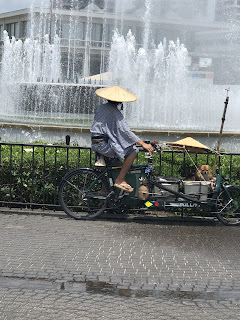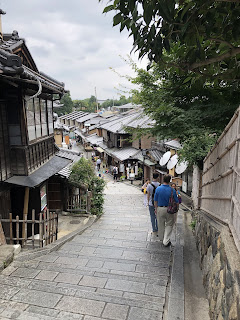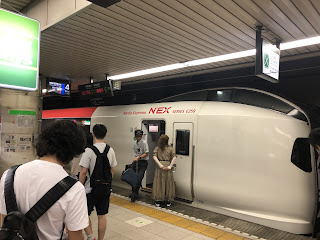Day in Hiroshima...Powerful, devastating and inspiring!
"The mission of the Hiroshima Peace Memorial Museum is to convey to people around the world the actual damage wrought by the atomic bombing, thereby pursuing Hiroshima's cherished desires: the abolition of nuclear weapons and realization of lasting world peace."
I did not take pictures inside the museum. It didn't seem respectful. What you will see are some photos before, at the end in the lobby and in the Peace Park outside the museum. Please check out their website http://hpmmuseum.jp/?lang=eng and you'll see why.
"A single atomic bomb indiscriminately killed tens of thousands of people, profoundly disrupting and altering the lives of the survivors."

This clock has two numbers: Number of days since the first dropping of the atomic bomb: 26,995. Number of days since the last nuclear test: 141 days.
The United States specifically chose Hiroshima because it would cause the most death and destruction. Scientists and the assistant Secretary of War wanted to bomb a less inhabited region to get Japan to unconditionally surrender. There were political concerns at the time like defending the cost of creating such a weapon and not using it and also worries about Russia gaining more power. Instead, they chose to bomb Hiroshima on August 6, 1945, where 70,000 died in the initial blast and another 70,000 died from injuries and radiation exposure. Many more have died since with cancers and other complications related to the bombing.
The U.S. dropped another bomb on Nagasaki on August 9th killing another 80,000 people.
The exhibits, photographs and stories are devastating! I cried the entire time!
Outside the museum is an area that has been dedicated to peace. This first monument embodies the hope that Hiroshima will stand as a city of peace. The stone chamber contains the register of the victims and a pledge on behalf of all humanity never to repeat the evil of war.


Through the chamber you can see the Flame of Peace. Lit on 1st August 1964 in hope of a world without nuclear weapons, the flame will continue to burn until nuclear weapons are abolished worldwide. The pedestal was designed in the image of two hands pressed together with the palms facing the sky.
At the foot of the statue it reads: This is our cry. This is our prayer. Peace on Earth." Every year on Obon Day, when the Japanese remember the departed spirits of loved ones, thousands of people leave paper cranes near the statue and many are housed in glass rooms around the statue.
I continued my walk around the park and made my way to the building called the A-Bomb Dome. This was the former Hiroshima Prefectural Commercial Exhibition Hall and was a beloved landmark in Hiroshima before the war. At 8:15 a.m. on August 6, 1945, the A-bomb exploded approximately 600 meters above and 160 meters southeast of this building, ripping through and igniting the building and instantly killing everyone in it. Because the blast was almost directly above, some of the walls remained standing and the iron frame of the dome stayed in place. Residents of Hiroshima decided to keep this tragic reminder of the bombing.
It was an absolutely gorgeous day. I hadn't seen the sun in a week so the wind off the water heading toward another beautiful place was just what I needed.
What is it about being on the ocean that is so good for the body and soul?
It's about a 1/2 mile to the Torii and on the way I caught some very friendly deer roaming the town. I think this small herd is waiting on a reservation. (insert deer pun here). :-)
The Torii is quite impressive. It was built in 1168 and is about 200 meters offshore. Here are some interesting facts about this structure:
If you know me you know that I collect rocks and have since forever. I have picked up rocks from all over the world. Today I was making it my mission to find a rock to take back with me. Did I find one? No! There were no rocks (other than little gravel sized ones) and I walked around the entire area. I did find other cool things.
I did not take pictures inside the museum. It didn't seem respectful. What you will see are some photos before, at the end in the lobby and in the Peace Park outside the museum. Please check out their website http://hpmmuseum.jp/?lang=eng and you'll see why.
Only in Asia will you capture such a wonderful image as the man and his dog above.
This is a view down to the park from the 2nd floor of the museum.

This clock has two numbers: Number of days since the first dropping of the atomic bomb: 26,995. Number of days since the last nuclear test: 141 days.
The United States specifically chose Hiroshima because it would cause the most death and destruction. Scientists and the assistant Secretary of War wanted to bomb a less inhabited region to get Japan to unconditionally surrender. There were political concerns at the time like defending the cost of creating such a weapon and not using it and also worries about Russia gaining more power. Instead, they chose to bomb Hiroshima on August 6, 1945, where 70,000 died in the initial blast and another 70,000 died from injuries and radiation exposure. Many more have died since with cancers and other complications related to the bombing.
The U.S. dropped another bomb on Nagasaki on August 9th killing another 80,000 people.
The exhibits, photographs and stories are devastating! I cried the entire time!
Outside the museum is an area that has been dedicated to peace. This first monument embodies the hope that Hiroshima will stand as a city of peace. The stone chamber contains the register of the victims and a pledge on behalf of all humanity never to repeat the evil of war.


Through the chamber you can see the Flame of Peace. Lit on 1st August 1964 in hope of a world without nuclear weapons, the flame will continue to burn until nuclear weapons are abolished worldwide. The pedestal was designed in the image of two hands pressed together with the palms facing the sky.
The Children's Peace Monument stands in memory of all the children who died as a result of the bombing. It was inspired by the death of Sadako Sasaki, who was exposed to the bomb's radiation at the age of two and died ten years later when she developed leukemia. Her classmates were called to action and began a campaign to build this monument. It was build in 1958. The statue on top is of a young girl lifting a golden crane. Sadako had heard the legend that if she folded 1,000 paper cranes, her wish would come true. Her wish was to get well...she had folded 644 at the time of her death. Some were so tiny that she used a pin to fold them.
At the foot of the statue it reads: This is our cry. This is our prayer. Peace on Earth." Every year on Obon Day, when the Japanese remember the departed spirits of loved ones, thousands of people leave paper cranes near the statue and many are housed in glass rooms around the statue.
I continued my walk around the park and made my way to the building called the A-Bomb Dome. This was the former Hiroshima Prefectural Commercial Exhibition Hall and was a beloved landmark in Hiroshima before the war. At 8:15 a.m. on August 6, 1945, the A-bomb exploded approximately 600 meters above and 160 meters southeast of this building, ripping through and igniting the building and instantly killing everyone in it. Because the blast was almost directly above, some of the walls remained standing and the iron frame of the dome stayed in place. Residents of Hiroshima decided to keep this tragic reminder of the bombing.
At this point I had spent over 4 hours at the museum and in the park, had shed many tears and felt completely depleted and disgusted with humanity (or lack thereof). I was ready for the second half of my day in Hiroshima.
Per usual I took the slowest mode of transportation possible to get to the ferry that would take me to Miyajima, an island off the coast of Hiroshima.
I took a 50 minute ride on the Hiroshima Electric Train through the city and down to the coast. Yes, I could have done it more quickly but I love being able to see the neighborhoods and everything in between destinations. It also was a good time to reflect. I then took a ferry to the island. It was such a perfect thing to do after the first half of my day.It was an absolutely gorgeous day. I hadn't seen the sun in a week so the wind off the water heading toward another beautiful place was just what I needed.
What is it about being on the ocean that is so good for the body and soul?
As we approached the island, I could see the very famous symbol of Miyajima, the great Torii, the boundary between the spirit and the human worlds.
Can you see it now?
Unfortunately (and fortunately) it was low tide. At high tide, it looks like it is floating on water, like this:
But the cool thing is, because it was low tide, we got to walk right up to it (well pretty close because there is work being done on the foundation).
The Torii is quite impressive. It was built in 1168 and is about 200 meters offshore. Here are some interesting facts about this structure:
- The base is not buried deep in the seabed like you would think but stands in place by its own weight.
- The box shaped upper part is filled with 7 tons of stones to keep it secure.
- The color is to keep evil spirits away.
The deer even wander down onto the beach.
If you know me you know that I collect rocks and have since forever. I have picked up rocks from all over the world. Today I was making it my mission to find a rock to take back with me. Did I find one? No! There were no rocks (other than little gravel sized ones) and I walked around the entire area. I did find other cool things.
I made my way back through the town markets, bought a local beer and returned to the ferry. This time I took the regular train back to Hiroshima Station and then the Shinkansen back to Kyoto.
Today was the 4th of July! I choose to celebrate and honor Peace!
“I shall write peace upon your wings,
and you shall fly around the world
so that children will no longer have
to die this way.”
―









































Comments
Post a Comment